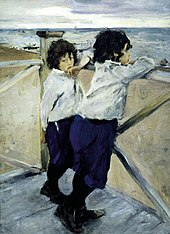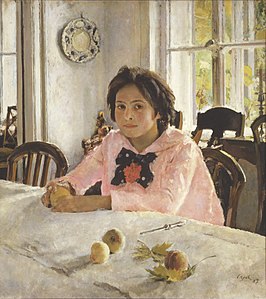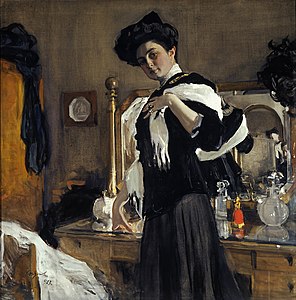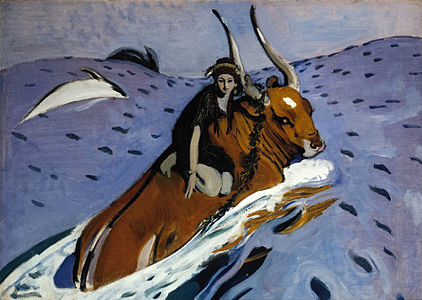Valentin Serov
Valentin Serov | |
|---|---|
 Portrait of Serov, 1902 | |
| Born | Valentin Alexandrovich Serov 19 January 1865 |
| Died | 5 December 1911 (aged 46) Moscow, Russia |
| Nationality | Russian |
| Education | Member Academy of Arts (1898) Full Member Academy of Arts (1903) |
| Alma mater | Imperial Academy of Arts |
| Known for | Portraits |
| Movement | Peredvizhniki, Impressionism, Mir iskusstva |
Valentin Alexandrovich Serov (Russian: Валентин Александрович Серов; 19 January [O.S. 7 January] 1865 – 5 December 1911) was a Russian painter and one of the premier portrait artists of his era.
Life and work
Youth and education
Serov was born in
Early works

The greatest works of Serov's early period were portraits: The Girl with Peaches (1887), and The Girl Covered by the Sun (1888), both in the Tretyakov Gallery. In these paintings Serov concentrated on spontaneity of perception of the model and nature. In the development of light and color, the complex harmony of reflections, the sense of atmospheric saturation, and the fresh picturesque perception of the world, there appeared the features of early Russian impressionism (though Serov was not yet aware of works of French impressionists at the time of making those paintings).
Portraiture and success
From 1890 on, the portrait became the basic genre in Serov's art. It was in this field that his early style would become apparent, the paintings notable for the psychologically pointed characteristics of his subjects. Serov's favorite models were actors, artists, and writers, such as Konstantin Korovin (1891), Isaac Levitan (1893), Nikolai Leskov (1894), and Nikolai Rimsky-Korsakov (1898)—all in the Tretyakov gallery.[1]

Initially abstaining from the polychromatic, brightly colored painting style of the 1880s, Serov often preferred a dominant scale of black-grey or brown tones.
At the same time, he developed a contrasting direction: he frequently produced intimate, heartfelt, chamber portraits, mainly of children and women. In portraits of children Serov aspired to capture pose and gesture, to reveal and emphasize a spontaneity of internal movement, sincere cleanliness and clearness of attitude of the child (Children, 1899, Russian Museum; Mika Morozov, 1901, Tretyakov gallery). Serov frequently called upon various graphic techniques—
Marriage and family

Serov married Olga Trubnikova in 1889. His wife and his children were the subject of many of his works. Notably, his painting Children was of his sons Yura and Sasha. His children were Olga, Alexander (Sacha), George (Yura), Michael and Anton.
Late work

During his late period, which began in 1900, Serov was a member of "
Serov's democratic beliefs were clearly shown during the
The last years of Serov's life were marked by works on themes from classical
Death
Valentin Serov died in Moscow on 5 December 1911, from stenocardia (an acute form of angina) that eventually led to cardiac arrest, ending in heart failure due to severe complications. He was buried at the Donskoye Cemetery. The Soviets had his remains exhumed and reburied at the Novodevichy Cemetery.
Legacy
The best works of Serov are among the greatest of Russian realistic art. He taught in the Moscow School of Painting, Sculpture and Architecture from 1897 to 1909), and among his students were Pavel Kuznetsov, N. N. Sapunov, Martiros Saryan, Kuzma Petrov-Vodkin, N. P. Ulyanov, and Konstantin Yuon.
A 2016 exhibition of Serov's work at the Tretyakov Gallery in Moscow attracted record crowds which queued for long hours in freezing temperatures.[2] Following the visit of Russian President Vladimir Putin, the crowd swelled to such an extent that one of the museum's doors was broken down.[2][3] Minister of Culture Vladimir Medinsky ordered the exhibition—and the gallery's opening hours—to be extended, and a field canteen was deployed to provide the people who were standing in the lines with buckwheat porridge and hot tea.[2]
A
Selected artwork
-
The girl with peaches (1887) was the painting that inaugurated Russian Impressionism.
-
Lilacs in Vase (1887)
-
Portrait ofIsaak Levitan(1893)
-
Iphigenia in Tauris (1893)
-
Portrait of Nikolai Rimsky-Korsakov (1898)
-
Portrait of Margarita Morozova's son Mika (1901)
-
Portrait of Princess Zinaida Yusupova (1900-1902)
-
Portrait of TsarNicholas II(1902)
-
Bathing of a horse (1905)
-
Portrait of Maxim Gorky (1905)
-
Portrait of Henriette Hirschmann (1907)
-
Portrait of Ivan Morozov (1910)
-
The Kidnapping of Europa (1910)
-
Portrait of Ida Rubinstein (1910)
-
Odysseus and Nausicaa (1910)
-
Portrait of Princess Olga Orlova (1911)
-
Portrait of Anna Benois wife of Alexandre Benois (1908)
-
Portrait of Lialia (Adelaida) Simonovich (1880)
-
Portrait of Maria Akimova (1908)
References
- ^ Kurdyukova, D. (2015-01-19). "Russian intelligentsia in the portraits by Valentin Serov". Russia Beyond The Headlines. Retrieved 2020-02-19.
- ^ a b c Kishkovsky, Sophia (28 January 2016). "Record crowds brave Moscow cold for blockbuster show". The Art Newspaper. Archived from the original on 21 February 2017. Retrieved 20 February 2017.
- ^ Cohen, Yaroslav; Vlasova, Olga. "Why Russians are so crazy about artist Serov". Russia Beyond the Headlines. Retrieved 20 February 2017.
- ISBN 3-540-00238-3.
External links
- A website dedicated to Valentin Serov
- www.Valentin-Aleksandrovich-Serov.org Images by Valentin Serov, biography, eCard, slideshow and more
- Valentin Serov. Biography and the best pictures. Excellent quality of reproductions.
- Olga Atroshchenko. The Most Moving Painter of the Human Face, The Tretyakov Gallery Magazine, 2015
- Valentin Serov. Heritage. Special issue of The Tretyakov Gallery Magazine, 2015




















